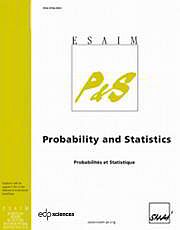No CrossRef data available.
Article contents
Statistical tools for discovering pseudo-periodicitiesinbiological sequences
Published online by Cambridge University Press: 15 August 2002
Abstract
Many protein sequences present non trivial periodicities, such ascysteine signatures and leucine heptads. These known periodicitiesprobably represent a small percentage of the total number of sequencesperiodic structures, and it is useful to have general tools todetect such sequences and their period in large databases ofsequences. We compare three statistics adapted from those used in timeseries analysis: a generalisation of the simple autocovariance basedon a similarity score and two statistics intending to increase thepower of the method. Theoretical behaviour of these statistics arederived, and the corresponding tests are then described. In this paperwe also present an application of these tests to a protein known tohave sequence periodicity.
- Type
- Research Article
- Information
- Copyright
- © EDP Sciences, SMAI, 2001


